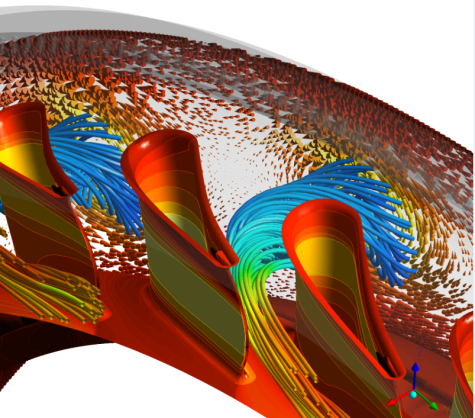The group Numerical Simulations at the Institute of Gas Turbines and Aerospace Propulsion is involved with the application of modern simulation tools for current problems in the development of turbomachine components. The focus of research is the validation of new numerical tools and their integration into the development process of modern jet engines. From the obtained findings, innovative design guidelines can be drawn. These findings can be applied to increase the efficiency of components and propose novel concepts in engine development. In this context, the institute cooperates with ANSYS within the framework of the Academic Research Program.
The group Numerical Simulations maintains a computing cluster at the at the institute for conducting simulations. The total computing capacity of the cluster is:
● 356 cores
● 1472 GB RAM Memory
By the modular design of the cluster, separate areas can be established for conducting simulations in the scope of different projects. From the cluster, the Lichtenberg-High Performance Computer of TU Darmstadt can be accessed.
The following software applications are used for simulations in the scope of the research projects and teaching activities at the institute:
● CFD/FEM software suite ANSYS
● CFD software suite TRACE
● CFD software suite Numeca
● Meshing software CENTAUR
In the context of cooperation with Rolls-Royce, the following Rolls-Royce software applications are also applied:
● CFD software suite AU3D
● CFD software suite HYDRA
● FEM software suite SC03
Numerical Prediction of Thermal Turbine Blade Behaviour
The development of novel high pressure turbine blades necessitates a numerical validation of the cooling design in order to guarantee on the one hand that the thermal loading capacity of the blade material is not being exceeded and on the other hand that there are no penalties on turbine efficiency due to waste of cooling air. Since conventional methods for determining the heat transfer on the blade walls are solely based on fluid simulations, the thermal back coupling between the solid and the fluid is being neglected. That is why conjugate heat transfer calculations are being employed which couple the fluid side thermal prediction with the thermal conduction of the solid structure. Within the scope of an ongoing research endeavour the physical processes within this fluid-solid interaction are to be investigated and understood in order to determine, by means of setting up numerical models, the full potential of conjugate heat transfer calculations with respect to the uncertainties of previous design processes.
Research campaign: Luftfahrtforschungsprogramm 5 (LuFo 5) Call 2
Combustion-Turbine-Interaction with pulsating combustion cycle
The efficiency of the aircrafts engine components has attained a high level and is stretched to its limits. To achieve a higher efficiency classes, it is necessary to apply innovative and revolutionary technologies, which are studied by the joint research project TREVAP. In this project technical solutions for future aircraft engines, which have not been considered in the past, are explored and evaluated. The proposed technical solutions are based on innovative cycle processes that are characterised by pulsating combustion cycles. In this campaign Pressure Gain Combustion methods play an important role.
With regard to Pressure Gain Combustion methods, two technological concepts are to be highlighted: Pulsed Detonation Engines (PDE), which are based on propulsion systems that rely on a detonative combustion process to produce pressure rise, and Wave Rotor Combustion Rigs (WRCR), which are based on rotating drums on a shaft with longitudinal tubes that periodically deliver hot gas to the high pressure turbine. Both concepts cause a transient aero-thermal load in the downstream turbine stage. The effects on the aerodynamics of conventional turbines are still mostly uncharted.
The Institute of Gas Turbines and Aerospace Propulsion pursues the aim to understand the underlying effects of transient inflow boundary conditions on loss mechanisms within a turbine stage. The main stress will be laid on weak spots and potentials of current turbine geometries with respect to transient inflow. The focus of research lies also on the impact of the thermal design and the cooling concept.
Research campaign: Luftfahrtforschungsprogramm 5 (LuFo 5) Call 2
Compressor Aeroelasticity
The compressor in a modern jet engine is accountable for around 50% of the engine’s weight and 50% of the overall size. Therefore, the reduction of weight is an important goal in the development of advanced compressors. This leads to the following design trends:
• Aerodynamically highly loaded blades for reduction of stage or blade count.
• BLISK-design for compressor rotors (blades and disk are manufactured as an integral part).
Due to the higher aerodynamic load and the omission of friction surfaces by BLISK-design, the susceptibility to blade vibrations increases. Especially critical are self-excited blade vibrations, which can occur unexpectedly from interaction of the blade vibration with the fluid flow. They have the potential to cause high oscillation amplitudes in a very short time. This can lead to blade rupture in the worst case.
At the Institute of Gas Turbines and Aerospace Propulsion, newest numerical tools are applied to carry out research in the area of compressor aeroelasticity. The investigations are carried out in close cooperation with the experimental projects at the institute. The objectives of the research are:
• Understanding of mechanisms that lead to self-excited blade vibrations.
• Investigation of measures for aeroelastic stabilization.
Research campaign: Luftfahrtforschungsprogramm 5 (LuFo 5)
Combustor Turbine Interaction (CTI)
New combustion technologies shall reduce the NOx emissions of modern civil aero-engines. They are characterized by a highly swirling combustor exit flow with temperature non-uniformities and high turbulence intensity. These have a negative effect on the efficiency and life time of the highly loaded high pressure turbine downstream. The underlying mechanisms of interaction of the flow field distributions at turbine inlet and in the stator vane passage are not yet fully understood. In the current project, the focus lies on the consideration and integration of unsteady effects into the analysis of the CTI. The process of combustion and the highly swirled flow in the combustor leads to large fluctuations of pressure, temperature and velocity at the turbine inlet. The common used methods with steady state simulation and averaged profiles as inlet boundary condition do not take these effects into account. To fully understand the mechanisms at the CTI it is necessary to expand the existing tools by temporal fluctuations and run high fidelity unsteady simulations with unsteady boundary conditions.
Research campaign: Luftfahrtforschungsprogramm 5 (LuFo 5) Call 3







